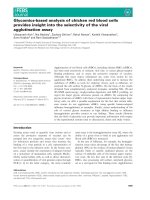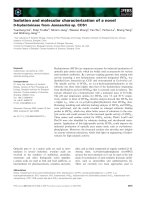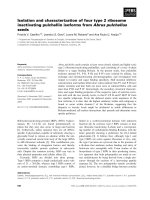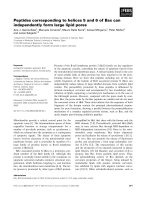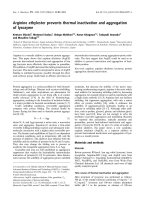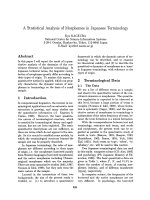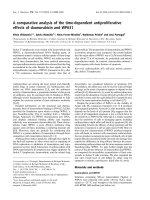Báo cáo khoa học " Isolation, composition analysis, antioxidant activity and cytotoxicity of selenium-enriched polysaccharide fractions isolated from Lentinula edodes mycelial cultures " potx
Bạn đang xem bản rút gọn của tài liệu. Xem và tải ngay bản đầy đủ của tài liệu tại đây (69.53 KB, 1 trang )
ABSTRACTS New Biotechnology · Volume 25S · September 2009
1.1.26
Isolation, composition analysis, antioxidant activity and
cytotoxicity of selenium-enriched polysaccharide frac-
tions isolated from Lentinula edodes mycelial cultures
J. Turło
1,∗
, B. Gutkowska
1
, F. Herold
1
, M. Cie
´
slak
2
, J. Ka
´
zmierczak-
Bara
´
nska
2
1
Medical University of Warsaw, Warsaw, Poland
2
Centre of Molecular andMacromolecular Studies, PolishAcademyof Sciences,
Lodz, Poland
Polysaccharide fractions isolated from Lentinula edodes fruit-
bodies and mycelium demonstrate strong immunomodulating,
antioxidant and anticancer activity. We hypothesized, that
polysaccharide fractions enriched in selenium would possess
higher biological activity than non-enriched fractions, currently
used to treat cancer. The first goal of this study was to iso-
late selenium (Se)-enriched polysaccharide fractions of different
molecular weight from L. edodes mycelium cultivated under the
submerged conditions in Se-enriched medium, and to investigate
their monosaccharide composition. The second objective was to
determine, whether there is relationship between the Se-content in
polysaccharide fractions and their antioxidant activity. Finally, we
tested Se-enriched polysaccharides for their cytotoxic properties
in HeLa (cervix carcinoma) and HUVEC (normal) cells. All results
regarding Se-enriched polysaccharides were compared with that of
reference polysaccharide fractions, extracted from mycelium not
enriched in Se.
Concentration of Se in the Se-enriched mycelium and in the
polysaccharide fractions was determined by reversed-phase high-
performance liquid chromatography (RP-HPLC). Total selenium
amount in the L. edodes mycelium, cultivated in Se-enriched
(20 ppm) medium, was 748 g/g. About 13% of total mycelial sele-
nium was combined to the polysaccharide fractions.
Four Se-enriched polysaccharide fractions were isolated from
the mycelium and from the culture medium. Monosaccharide
composition of selenated polysaccharides was determined, after
hydrolysis performed by the use of trifluoroacetic acid, by RP-HPLC
method. Se-enriched fractions isolated from mycelium contained
34% of glucose, 9% of xylose, 15% of mannose and 23% of glu-
cosamine. Se-enriched fractions of molecular weight 400 kDa and
200 kDa differed mainly in mannose and galactose content. Se-
enriched polysaccharides extracted from the cultivation medium
contained mainly glucose and mannose. Reference fractions con-
tained mainly glucose (38%), xylose (25%) and mannose (15%).
For in vitro determination of antioxidant properties of polysac-
charide fractions DETBA and conjugated diene methods were used.
Antioxidant activity of Se-enriched polysaccharides was enhanced
by 50—400%, as compared with control polysaccharide fractions.
The comparison of cytotoxic profiles of tested fractions revealed
that, except for fraction of molecular weight 200 kDa isolated from
the culture medium, other polysaccharides are not toxic toward
HUVEC or HeLa cells. However, the Se-enriched mycelial polysac-
charide fraction of high molecular weight significantly enhances
viability of cells; this may be an effect of the increased antioxidant
activity.
doi:10.1016/j.nbt.2009.06.031
1.1.27
Effects of the natural sweetener (stevia) and the artificial
sweetener (aspartame) on some biochemical parameters
in normal and alloxan-induced diabetic rats
N. Agamy
High Institute of Public Health, Alexandria, Egypt
One way to control excessive energy intake is to replace the calo-
ries from sugar with a non-nutritive sweetener, aspartame received
more attention in the media about its safety while stevia leaf or
extracted form has been used in many countries as a sweetener
and in traditional medicine for the treatment of diabetes but still
not approved as a sweetener by the FDA. This study was under-
taken to compare the effects of consumption of stevioside (as a
natural sweetener) and aspartame (artificial sweetener) on glucose
level, lipid profile, liver and kidney functions, acetylcholinesterase
of normal and alloxan-induced diabetic rats.
140 male Wistar rats were used; half of them were injected with
120 mg/kg alloxan for the induction of diabetes. Both normal and
diabetic groups were treated with stevioside and aspartame with
three different doses (representing the ADI, twice ADI and four
times ADI of each) for four weeks. Rats were sacrificed by cervi-
cal decapitation and fasting blood specimens were collected and
tested.
Results showed that although treating diabetic rats with stevio-
side doses resulted in lowering glucose levels than that of untreated
diabetics that were ranging from 55.6% to 62.6%, they were still
above the normal glucose range. The percentage decrease in glu-
cose levels was dose dependent. The medium dose of stevioside
significantly improved cholesterol (59%), liver enzymes activities
of diabetic rats and returned them back to their normal ranges
where the highest reductions of AST, ALT and ALP (more than 50%)
were found in the medium and high doses with no significant
differences among its different doses. Aspartame doses insignif-
icantly affect glucose, lipid profile and liver enzymes. Urea and
creatinine levels returned to their normal range. The percentage
increase of acetylcholinesterase activity was higher on treating dia-
betic rats with steviosides that reached 23.7% in its medium dose
than on treating them with aspartame that reached 16.7% in high
dose.
Stevioside doses were more efficient in improving plasma glu-
cose levels and acetylcholinesterase levels in diabetic rats than the
corresponding doses of aspartame. The medium steviosides dose
was more efficient in improving lipid profile and liver function
enzymes levels while its low and high doses were more efficient
in improving kidney function levels. The effect of different doses
of steviosides on the biochemical parameters of normal rats was
always within their normal range, by contrast, different doses of
aspartame have a remarkable adverse effect on acetylcholinesterase
levels even in normal rats.
doi:10.1016/j.nbt.2009.06.032
S12 www.elsevier.com/locate/nbt
